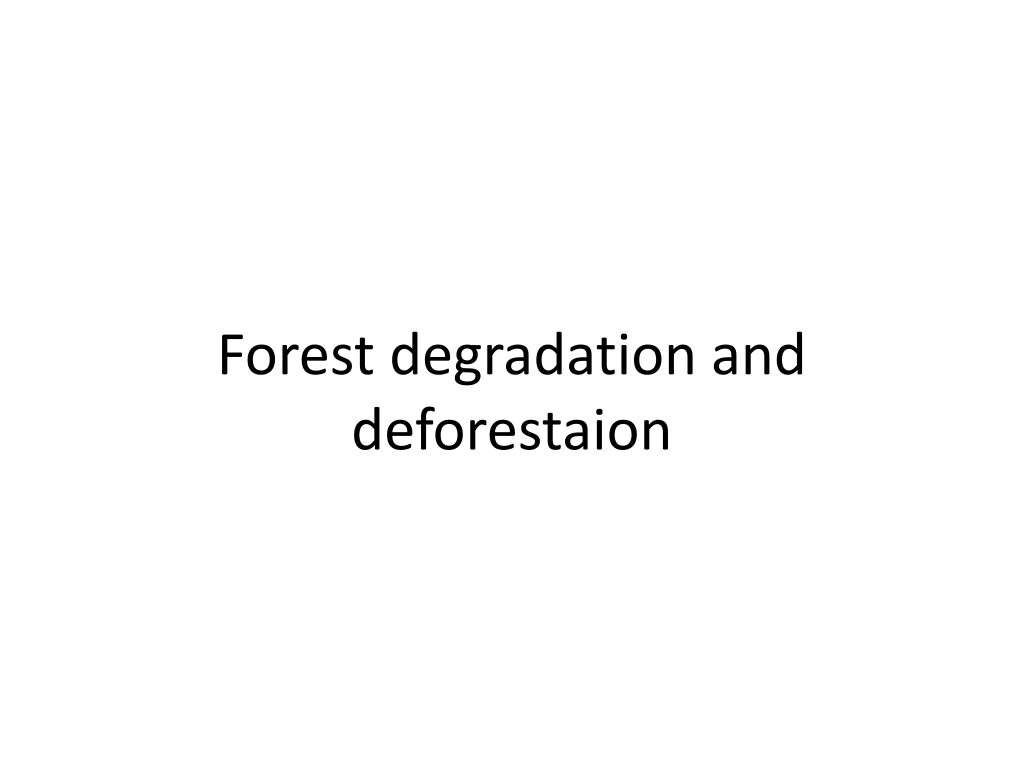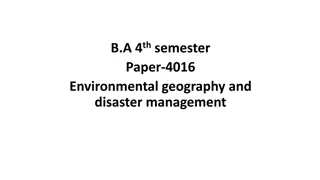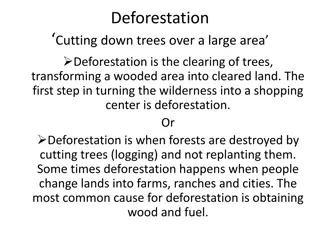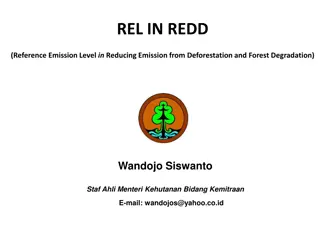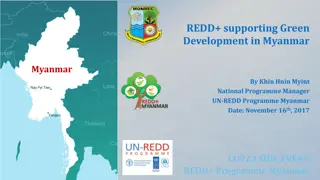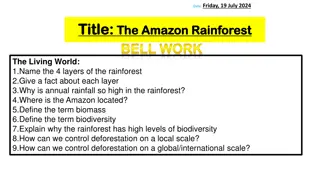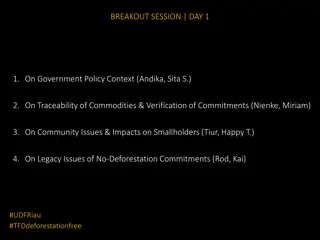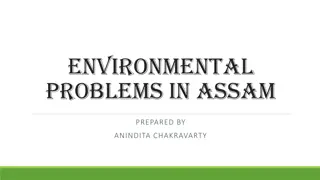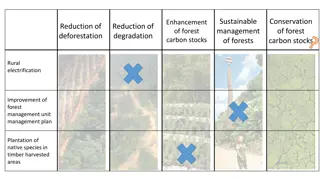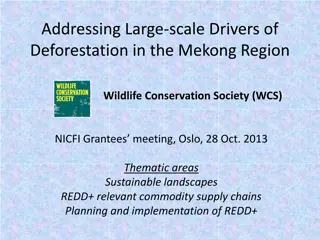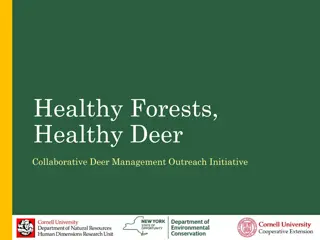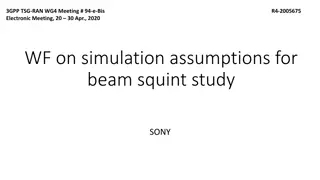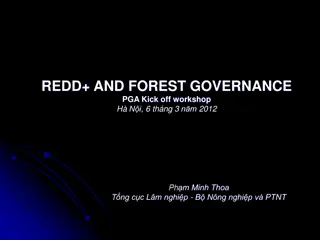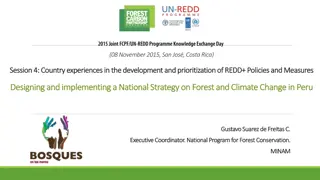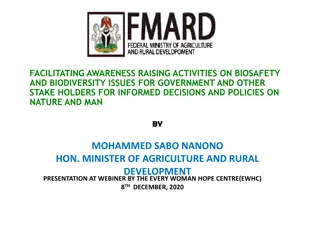Understanding Deforestation and Forest Degradation: Causes and Impacts
Deforestation and forest degradation are significant environmental issues driven primarily by agriculture, logging, and population growth. Other causes include corruption, inequitable distribution of wealth and power, and urbanization. Globalization and historical exploitation also play a role. Developing countries argue for fair treatment due to past deforestation by developed nations. Addressing these complex factors is crucial in preserving forest ecosystems and mitigating climate change impacts.
Download Presentation

Please find below an Image/Link to download the presentation.
The content on the website is provided AS IS for your information and personal use only. It may not be sold, licensed, or shared on other websites without obtaining consent from the author. Download presentation by click this link. If you encounter any issues during the download, it is possible that the publisher has removed the file from their server.
E N D
Presentation Transcript
Forest degradation and deforestaion
Causes According to the United Nations Framework Convention on Climate Change (UNFCCC) secretariat, the overwhelming direct cause of deforestation is agriculture. Subsistence farming is responsible for 48% of deforestation; commercial agriculture is responsible for 32% of deforestation; logging is responsible for 14% of deforestation and fuel wood removals make up 5% of deforestation.[9] Experts do not agree on whether industrial logging is an important contributor to global deforestation.[10][11]Some argue that poor people are more likely to clear forest because they have no alternatives, others that the poor lack the ability to pay for the materials and labour needed to clear forest.[10]One study found that population increases due to high fertility rates were a primary driver of tropical deforestation in only 8% of cases.[
Other causes of contemporary deforestation may include corruption of government institutions,[13][14]the inequitable distribution of wealth and power,[15]population growth[16]and overpopulation,[17][18]and urbanization.[19]Globalization is often viewed as another root cause of deforestation,[20][21]though there are cases in which the impacts of globalization (new flows of labor, capital, commodities, and ideas) have promoted localized forest recovery. In 2000 the United Nations Food and Agriculture Organization (FAO) found that "the role of population dynamics in a local setting may vary from decisive to negligible," and that deforestation can result from "a combination of population pressure and stagnating economic, social and technological conditions The degradation of forest ecosystems has also been traced to economic incentives that make forest conversion appear more profitable than forest conservation.[23]Many important forest functions have no markets, and hence, no economic value that is readily apparent to the forests' owners or the communities that rely on forests for their well-being.[ From the perspective of the developing world, the benefits of forest as carbon sinks or biodiversity reserves go primarily to richer developed nations and there is insufficient compensation for these services.
Developing countries feel that some countries in the developed world, such as the United States of America, cut down their forests centuries ago and benefited greatly from this deforestation, and that it is hypocritical to deny developing countries the same opportunities: that the poor shouldn't have to bear the cost of preservation when the rich created the problem.[24] Some commentators have noted a shift in the drivers of deforestation over the past 30 years.[25]Whereas deforestation was primarily driven by subsistence activities and government- sponsored development projects like transmigration in countries like Indonesia and colonization in Latin America, India, Java, and so on, during late 19th century and the earlier half of the 20th century. By the 1990s the majority of deforestation was caused by industrial factors, including extractive industries, large-scale cattle ranching, and extensive agriculture.[26]
Causes and factors It is important at the outset to carefully distinguish between the underlying causes of deforestation and forest degradation, about which there might be divergent views, and the actual factors, which could be part of the area of objective observation. For instance, in dealing with deforestation in developing tropical countries, the expansion, by means of clearing, of the different forms of subsistence agriculture, of cash cropping, or of ranching are all evident factors. The underlying causes are the triggering mechanisms for these factors. In the case of the first factor, we might say that the farmers' poverty obliges them to clear more land in order to enable them to buy the inputs that would allow them to produce more on less land, and that their poverty is itself engendered by their difficulty to sell what they produce, as a result of the insufficient farm price supports, due to the low priority given to the farming sector. We can go back a long way in this manner to find the underlying causes, with the increasing risk however of uncertainty, subjectivity and ideological posing. We will therefore limit ourselves to studying the factors.
Direct and indirect factors The factors are either direct -in the case of deforestation in developing tropical countries, the replacement of a forest area by a field of coffee trees is due to cash cropping which is the direct and visible factor -, or indirect, as for example the opening of a road (public or for forest logging) in a forest zone, which, in addition to being a direct factor of relatively small significance (eliminating a strip of forest along the road) attracts farmers in search of land who will clear the forest for cultivation. With regard to the area cleared by these farmers, there is a direct factor - farming - as well as an indirect one - the colonization or forest logging programme. There is a question to be asked, as well as a precautionary measure to be taken in this regard:
Should one attribute deforestation to the direct factor, to the indirect factor, or to both? In our view, we must always consider the direct factor either as the only one or as one of the two factors, but under no circumstances can we consider the indirect factor as the only one; If we attribute deforestation to both the direct and indirect factors, we must avoid a double accounting in our total deforestation estimate
deforestation: this involves a decrease in the area covered by forest. However, it cannot be so defined without adding a reference to its use (or allocation). In point of fact, there exist certain forms of forest utilization - and priority objectives of forest management - that clear temporarily the forest cover while guaranteeing its maintenance. This is the case of clearcutting of areas where forest will regenerate itself or be regenerated, or of the final cut in an even-aged forest sylvicultural treatment once natural regeneration has been assured. In other words, there is no deforestation if there is a guarantee of continuity in maintaining the forest cover;
degradation: this does not involve a reduction of the forest area, but rather a quality decrease in its condition, this being related to one or a number of different forest ecosystem components (vegetation layer, fauna, soil, ...), to the interactions between these components, and more generally to its functioning. The estimation of degradation can be hampered by a number of difficulties that are notably caused by:the different choices of the initial state of reference: "climax" or its numerous substitutes, the forest condition which corresponds to the silvicultural model that was adopted, ...; the criteria (with their indicators) one favours: health and vitality, species diversity, the production capacity of market or non-market goods and services; depending upon whether we limit ourselves to the present date, or whether we consider that the present state is only transitory and leads to a satisfactory, or even improved, later state.
The case of plantations It has often been the practice, particularly with regard to the tropics, to record separately changes in the "natural" or "semi-natural" forest areas - whether positive (natural reforestation) or negative (deforestation), from those related to man made forests (plantations), given the generally very different nature of these two categories of stands. Moreover, it is important to differentiate clearly between: plantations established on lands that were not classified as forest lands until now: this is afforestation and results in an increase in the total forest area; and plantations established on lands that have been temporarily cleared and which replace the previous forest stands: this is reforestation and the total forest area has remained quantitatively unchanged.
Deforestation defined broadly can include not only conversion to non-forest, but also degradation that reduces forest quality - the density and structure of the trees, the ecological services supplied, the biomass of plants and animals, the species diversity and the genetic diversity. A narrow definition of deforestation is: the removal of forest cover to an extent that allows for alternative land use. The United Nations Research Institute for Social Development (UNRISD) uses a broad definition of deforestation, while the Food and Agriculture Organization of the UN (FAO) uses a narrow definition.
What are the Major Causes of Deforestation? (1) Expansion of Agriculture: Expanding agriculture is one of the most important causes of deforestation. As demands on agricultural products rise more and more land is brought under cultivation for which forests are cleared, grass-lands ploughed, uneven grounds leveled, marshes drained and even land under water is reclaimed. However, this expansion is usually marked with more ecological destruction than rationality. Governments often distribute land under forests to landless people, instead of redistributing already established farm-lands, howsoever, wasteful, unequal and unjust the distribution of ownership of land may be. (2) Extension of Cultivation on Hill Slopes: Outside humid tropical zone, in most of the third world countries, major forests often occur on hill tops and slopes. Though agriculture has nearly always been concentrated on plains and floors of valleys, farming on narrow flat steps cut one after another across the slope or terrace farming is an age-old practice. It has never been extensive because of the gruelling labour and low productivity.
(3) Shifting Cultivation: Shifting cultivation or Jhum is often blamed for destruction of forests. In fact it is poor fertility of soil which has given rise to such a pattern of farming. A small patch of tropical forest is cleared, vegetation slashed, destroyed and burned. Crops are grown as long as the soil is productive, after which the cultivation is abandoned and cultivators move on to fresh patch of land. (4) Cattle Ranching: Large areas of tropical forests in Central and South America have been cleared for use as grazing land to raise catties and cash in on the lucrative beef exports to USA. The soil degenerates within a short span of time due to over-grazing and massive soil erosion occurs, Cattle ranching has done much damage to the tropical forest cover in South and central America. (5) Firewood Collection: To majority of rural population and a large number of people living in small towns and cities of developing countries, the only fuel is wood which is burned to cook food and to provide heat in chilly winters. (6) Timber Harvesting: Timber resource is an important asset for a country's prosperity. Commercial wood finds ready national as well as international markets. As a consequence of which natural forests are being mercilessly exploited. Logging or felling of forest trees for obtaining timber is an important cause of deforestation in third world countries.
Ombattu Gudda in the western Ghats of Karnataka
Western Ghats as seen from Gobichettipalayam, Tamil Nadu
Shola Grasslands and forests in the Kudremukh National Park, Western Ghats, Karnataka.
View from Varandha Pass showing the numerous waterfalls
The Jog Falls in Karnataka, one of the most spectacular waterfalls in India
Sakaleshpur-Hassan highway in Karnataka runs through the Western Ghats
DEFINITION OF FOREST DEGRADATION:~ Impoverishment of standing woody material mainly caused by human activities such as over-grazing, over-exploitation (for firewood in particular), repeated fires, or due attacks by insects, diseases, plant parasites or other natural causes such as cyclones. Very often degradation does not show up so much in decrease of woody vegetation but rather as a gradual reduction in biomass, changes in species composition and soil degradation.
Flora The damp forested slopes are the original location of Piper nigrum, the black pepper of history and commerce.
The term forest degradation is sometimes used in forestry, existing definitions are generally inadequate to capture actions that change carbon stocks because they lack specificity. These definitions commonly refer to reductions in the productive capacity of the forest and changes within the forest class (from closed to open forest), which negatively affect the stand or site and, in particular, that lower the biological productivity capacity and diversity.
Questions and answers on deforestation and forest degradation 1) What is deforestation and forest degradation? Deforestation refers to the destruction and conversion of forest land to other land uses usually considered more profitable. Forest degradation is used to mean the destruction of specific aspects of forests such as a decrease in tree cover, changes in their structure or a reduction in the number of species that can be found there. 2) What is the extent of the problem? Forests cover roughly 30% of the world's land area. According to the United Nations Food and Agricultural Organisation (FAO), the annual rate of deforestation is about 13 million hectares per year (approximately the size of Greece). Three percent of the earth's forest cover was lost between 1990 and 2005 and there has been no significant decrease in the rate of deforestation over the past 20 years. Some 96% of deforestation occurs in tropical regions.
4) What are the causes of deforestation and forest degradation? Deforestation can occur as a result of direct and indirect economic, institutional, political, natural or social factors. Their importance varies among countries and regions, within countries themselves and can change over time. The causes of deforestation often originate outside the forestry sector, thus making it challenging to find a global solution. Some of the main direct causes include changes in land uses for agricultural purposes, mining, and infrastructure development. Indirect causes include institutional and governance weakness, such as the unclear definition of land tenure and property rights, weak law enforcement capacity, incentives to convert forest land to other uses, and insufficient human resources to monitor forests. The underlying cause of governance failure is that the benefits derived from forest conservation and sustainable forest management are often not marketable, and have no commercial value. Unsustainable and illegal logging can contribute to deforestation and forest degradation. This is the reason why the Commission is proposing a new Regulation to address the trade in illegally harvested timber in the EU.
5) What are the negative impacts of deforestation? The negative impact of deforestation can be felt in economic terms, but also in the environment and society in general, especially on climate, biodiversity and poverty. The total amount of deforestation throughout the world contributes to climate change since it is responsible for 20% of global carbon dioxide emissions, more than total EU greenhouse gas emissions. It also causes biodiversity loss, flooding and soil degradation and increases the likelihood of natural hazards storms, floods, and extreme fluctuations in weather. Deforestation threatens the livelihoods and cultural integrity of people that depend on forests and it undermines the availability of timber and non-timber forest products for future generations.
9) What is the Global Forest Carbon Mechanism? The Global Forest Carbon Mechanism is a financial mechanism through which developing countries would be rewarded for emissions reductions achieved by taking action to reduce deforestation and forest degradation. This proposal intends to feed into the ongoing international negotiations on policy approaches to reduce deforestation and forest degradation in developing countries that were launched in December 2007 in the context of the Bali Action Plan. The Communication proposes key features for the architecture of such a mechanism, as well as possible ways for the EU to contribute to it. This proposal will have to be debated and further designed in the context of the international negotiations on climate change
13) Shouldn't the plantation of new forests be encouraged to compensate for deforestation? In terms of environmental services, it is better to avoid deforestation than to cut down trees and reforest subsequently, as deforestation leads to some irreversible effects in terms of biodiversity loss and soil degradation. Old- growth natural forests store a huge amount of carbon, both in the trees and in the soils. When young forests are established on formerly deforested land, far more CO2is emitted into the atmosphere during the deforestation phase than the re-growth absorbs. While plantations of new forests on available land is a useful measure to combat climate change, halving gross tropical deforestation by 2020 will deliver the largest share of the environmental benefits.
